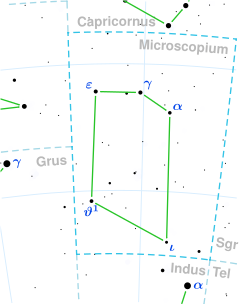K-type giant in Microscopium
HD 200073 (HR 8046; 43 G. Microscopii ) is a solitary star located in the southern constellation Microscopium ′ Zeta Microscopii . It is faintly visible to the naked eye as an orange-hued point of light with an apparent magnitude of 5.94.[ 2] light-years based on Gaia DR3 parallax measurements, but it is receding with a heliocentric radial velocity of km/s [ 6] interstellar extinction of 0.13 magnitudes [ 15] absolute magnitude of +1.79.[ 7] proper motion across the celestial sphere , moving at a rate of 213 mas/yr.[ 1]
HD 200073 has a stellar classification of K2 III,[ 4] evolved K-type giant that has exhausted hydrogen at its core and left the main sequence . Astronomer David Stanley Evans gave a class of K0 IV,[ 5] subgiant that is ceasing hydrogen fusion at its core. HD 200073 is currently on the red giant branch ,[ 3] helium core. It has a comparable mass to the Sun [ 8] billion years ,[ 12] radius of the Sun .[ 9] luminosity of the Sun [ 1] photosphere at an effective temperature of K [ 10] iron abundance of [Fe/H] = −0.13 or 74.1% of the Sun's.[ 8] projected rotational velocity of km/s [ 11]
References
^ a b c d e f g Vallenari, A.; et al. (Gaia collaboration) (2023). "Gaia Data Release 3. Summary of the content and survey properties" . Astronomy and Astrophysics . 674 : A1. arXiv :2208.00211 Bibcode :2023A&A...674A...1G . doi :10.1051/0004-6361/202243940 S2CID 244398875 . Gaia DR3 record for this source at VizieR .^ a b c Johnson, H. L.; Mitchell, R. I.; Iriarte, B.; Wisniewski, W. Z. (1966). "UBVRIJKL Photometry of the Bright Stars". Communications of the Lunar and Planetary Laboratory . 4 : 99– 110. Bibcode :1966CoLPL...4...99J . ^ a b Jones, M. I.; Jenkins, J. S.; Rojo, P.; Melo, C. H. F. (December 2011). "Study of the impact of the post-MS evolution of the host star on the orbits of close-in planets: I. Sample definition and physical properties⋆⋆⋆" . Astronomy & Astrophysics . 536 : A71. arXiv :1110.6459 Bibcode :2011A&A...536A..71J . doi :10.1051/0004-6361/201117887 ISSN 0004-6361 . ^ a b Houk, N. (1982). Michigan Catalogue of Two-dimensional Spectral Types for the HD stars. Declinations −40° to −26° . Vol. 3. Bibcode :1982mcts.book.....H . ^ a b Evans, D. S.; Laing, J. D.; Menzies, A.; Stoy, R. H. (1964). "Fundamental data for southern stars (fifth list)". Royal Greenwich Observatory Bulletins . 85 : 207– 224. Bibcode :1964RGOB...85..207E . ^ a b Kharchenko, N.V.; Scholz, R.-D.; Piskunov, A.E.; Röser, S.; Schilbach, E. (November 2007). "Astrophysical supplements to the ASCC-2.5: Ia. Radial velocities of ~55000 stars and mean radial velocities of 516 Galactic open clusters and associations". Astronomische Nachrichten . 328 (9): 889– 896. arXiv :0705.0878 Bibcode :2007AN....328..889K . doi :10.1002/asna.200710776 . eISSN 1521-3994 . ISSN 0004-6337 . S2CID 119323941 . ^ a b Anderson, E.; Francis, Ch. (May 2012). "XHIP: An extended hipparcos compilation". Astronomy Letters . 38 (5): 331– 346. arXiv :1108.4971 Bibcode :2012AstL...38..331A . doi :10.1134/S1063773712050015 . eISSN 1562-6873 . ISSN 1063-7737 . S2CID 119257644 . ^ a b c d e Wittenmyer, Robert A.; Liu, Fan; Wang, Liang; Casagrande, Luca; Johnson, John Asher; Tinney, C. G. (June 24, 2016). "The Pan-Pacific Planet Search. V. Fundamental Parameters for 164 Evolved Stars" . The Astronomical Journal . 152 (1). American Astronomical Society: 19. arXiv :1605.00323 Bibcode :2016AJ....152...19W . doi :10.3847/0004-6256/152/1/19 ISSN 1538-3881 . S2CID 55991800 . ^ a b Kervella, P.; Thévenin, F.; Di Folco, E.; Ségransan, D. (April 8, 2004). "The angular sizes of dwarf stars and subgiants: Surface brightness relations calibrated by interferometry" . Astronomy & Astrophysics . 426 (1): 297– 307. arXiv :astro-ph/0404180 Bibcode :2004A&A...426..297K . doi :10.1051/0004-6361:20035930 eISSN 1432-0746 . ISSN 0004-6361 . S2CID 6077801 . ^ a b Stassun, Keivan G.; et al. (9 September 2019). "The Revised TESS Input Catalog and Candidate Target List" . The Astronomical Journal . 158 (4): 138. arXiv :1905.10694 Bibcode :2019AJ....158..138S . doi :10.3847/1538-3881/ab3467 eISSN 1538-3881 . hdl :1721.1/124721 S2CID 166227927 . ^ a b De Medeiros, J. R.; Alves, S.; Udry, S.; Andersen, J.; Nordström, B.; Mayor, M. (January 2014). "A catalog of rotational and radial velocities for evolved stars V: Southern stars *" . Astronomy & Astrophysics . 561 : A126. arXiv :1312.3474 Bibcode :2014A&A...561A.126D . doi :10.1051/0004-6361/201220762 eISSN 1432-0746 . ISSN 0004-6361 . S2CID 54046583 . ^ a b Soto, M. G.; Jones, M. I.; Jenkins, J. S. (March 2021). "SPECIES. II. Stellar parameters of the EXPRESS giant star sample" . Astronomy & Astrophysics . 647 : A157 (23). arXiv :2009.03371 Bibcode :2021A&A...647A.157S . doi :10.1051/0004-6361/202039357 eISSN 1432-0746 . ISSN 0004-6361 . S2CID 221534230 . ^ Gould, Benjamin Apthorp (1878). "Uranometria Argentina : brillantez y posicion de las estrellas fijas, hasta la septima magnitud, comprendidas dentro de cien grados del polo austral : con atlas". Resultados del Observatorio Nacional Argentino . 1 . Bibcode :1879RNAO....1.....G . ^ "HD 200073" . SIMBAD Centre de données astronomiques de Strasbourg . Retrieved November 11, 2023 .^ Gontcharov, George A.; Mosenkov, Aleksandr V. (28 September 2017). "Verifying reddening and extinction for Gaia DR1 TGAS main sequence stars" . Monthly Notices of the Royal Astronomical Society . 472 (4): 3805– 3820. arXiv :1709.01160 Bibcode :2017MNRAS.472.3805G . doi :10.1093/mnras/stx2219 eISSN 1365-2966 . ISSN 0035-8711 . S2CID 118879856 .
